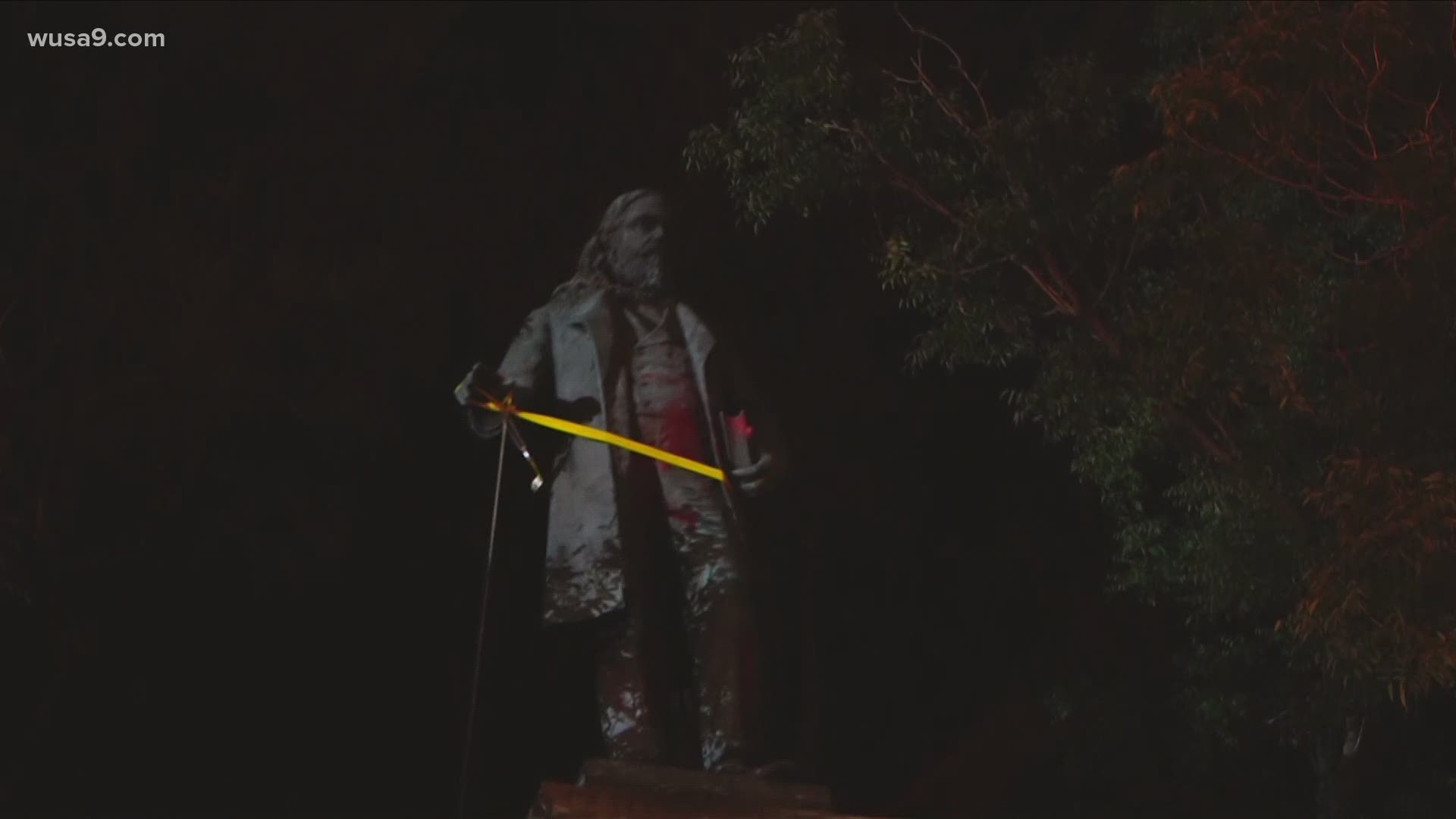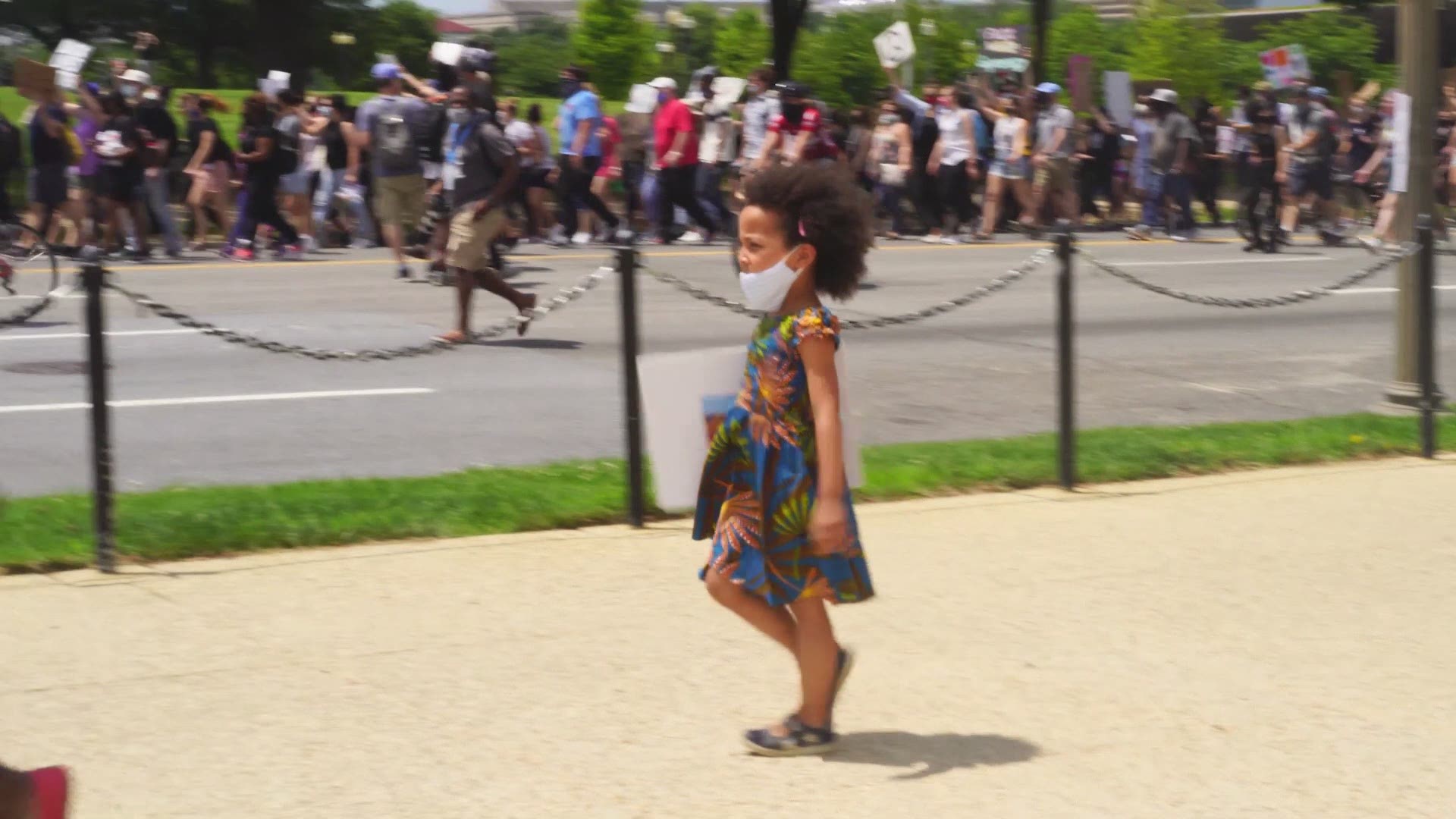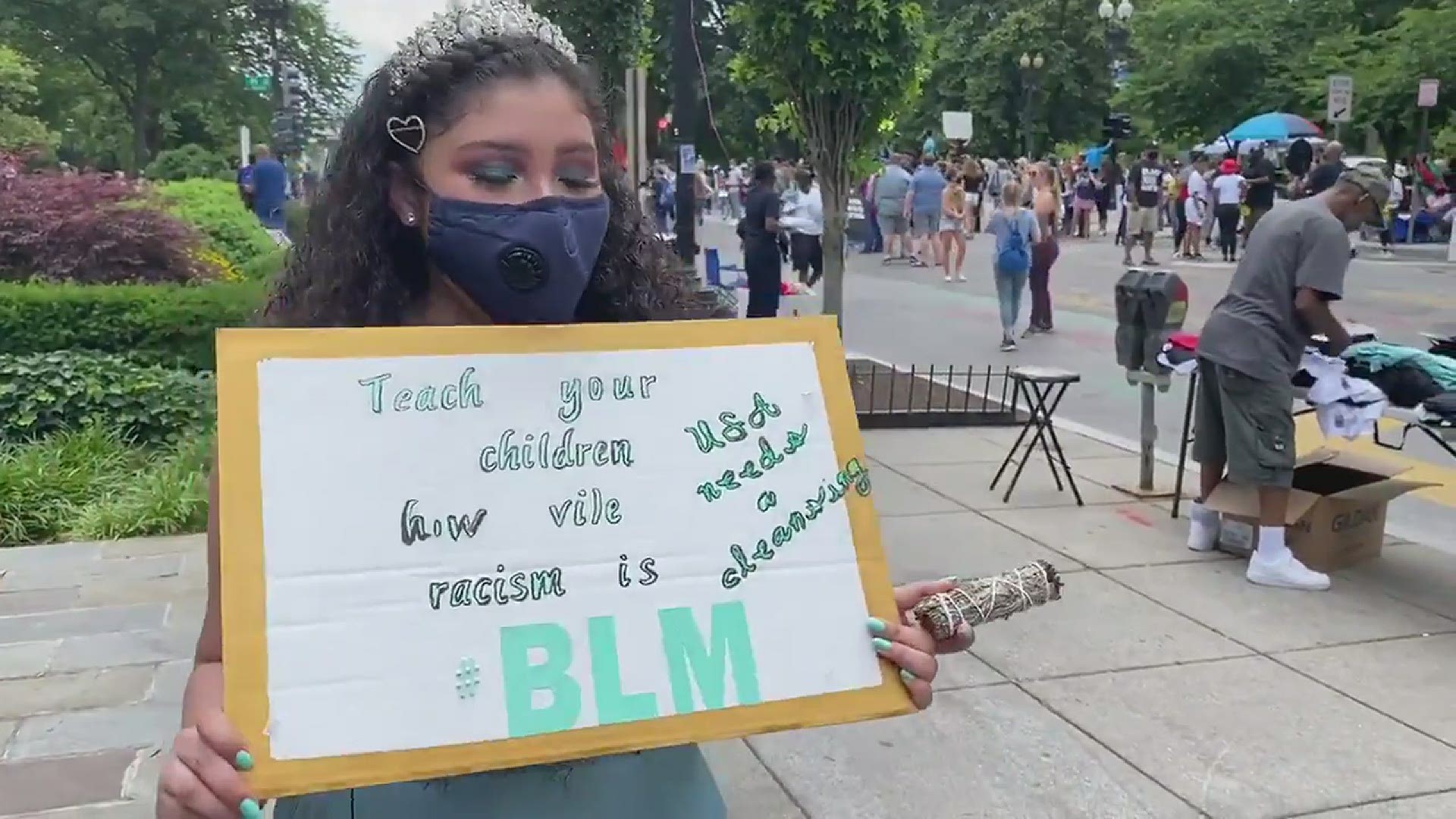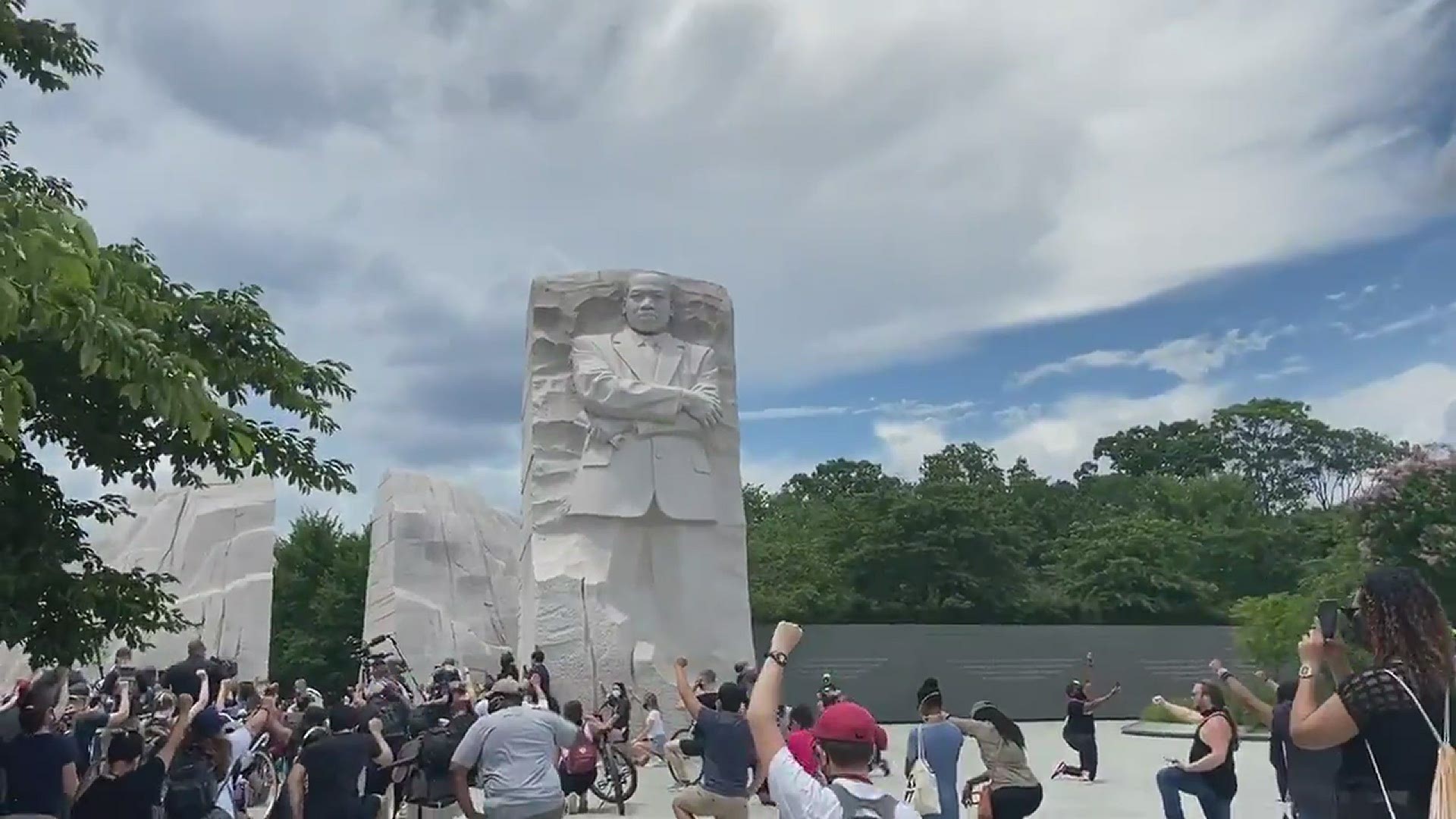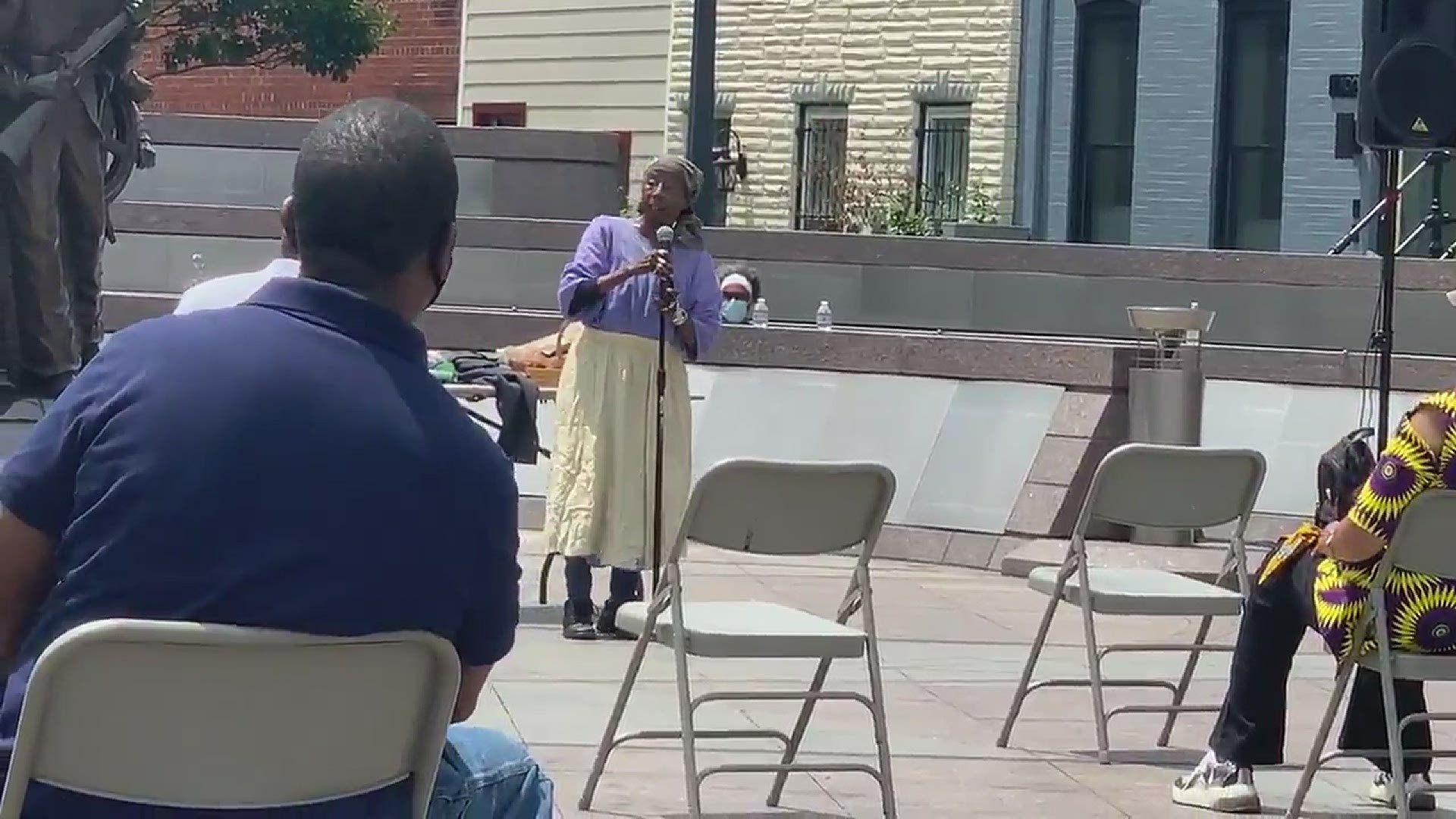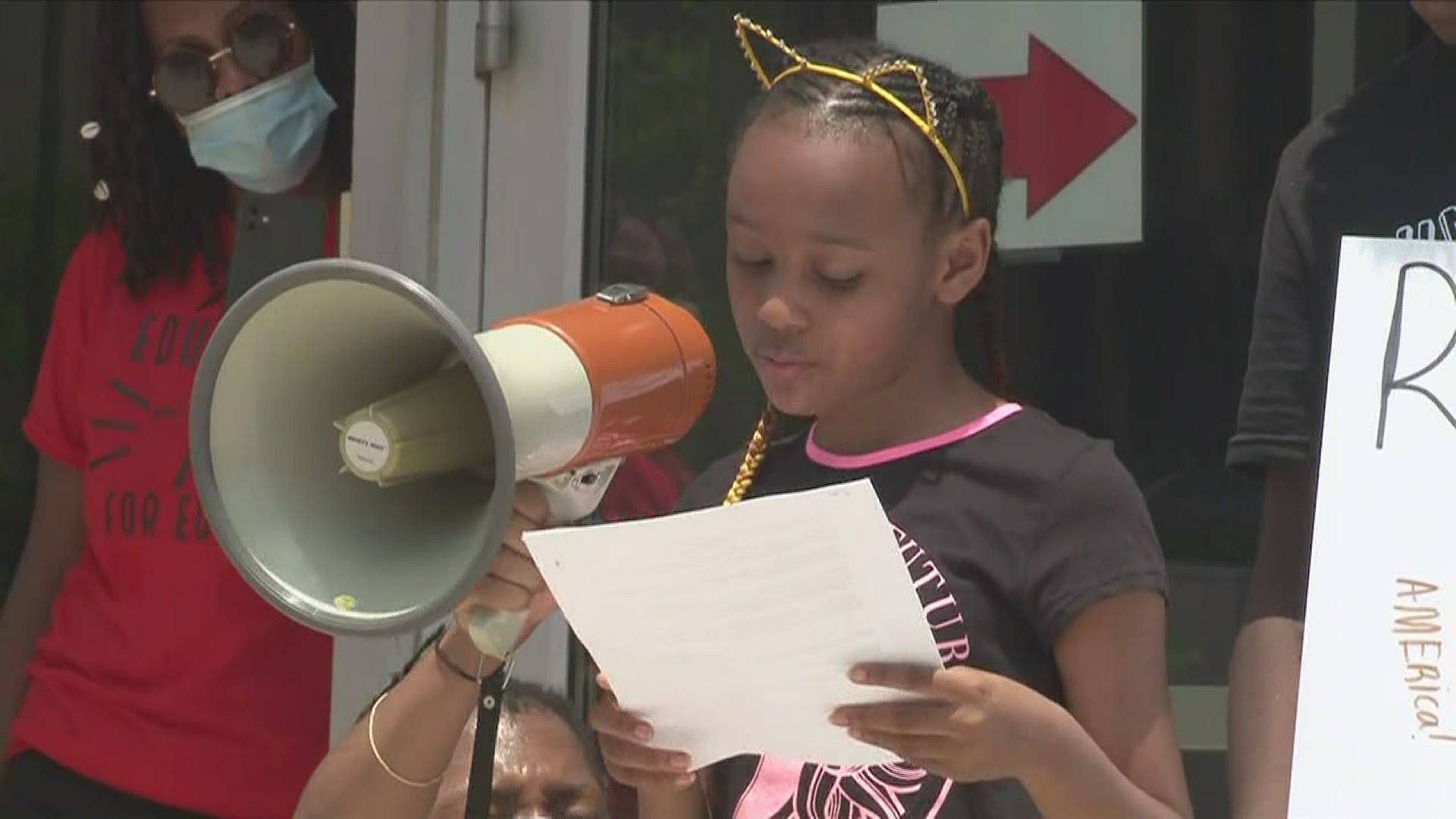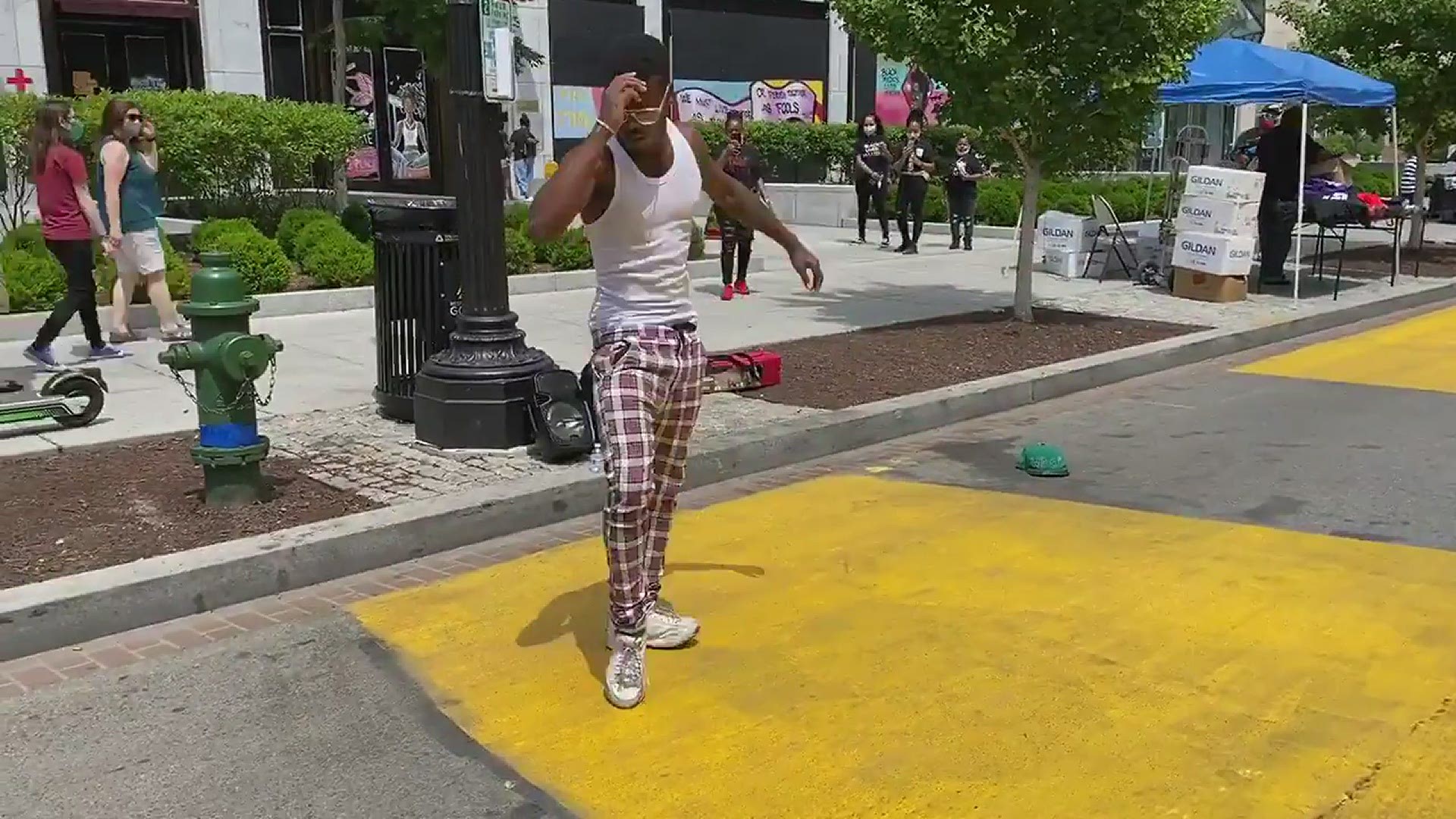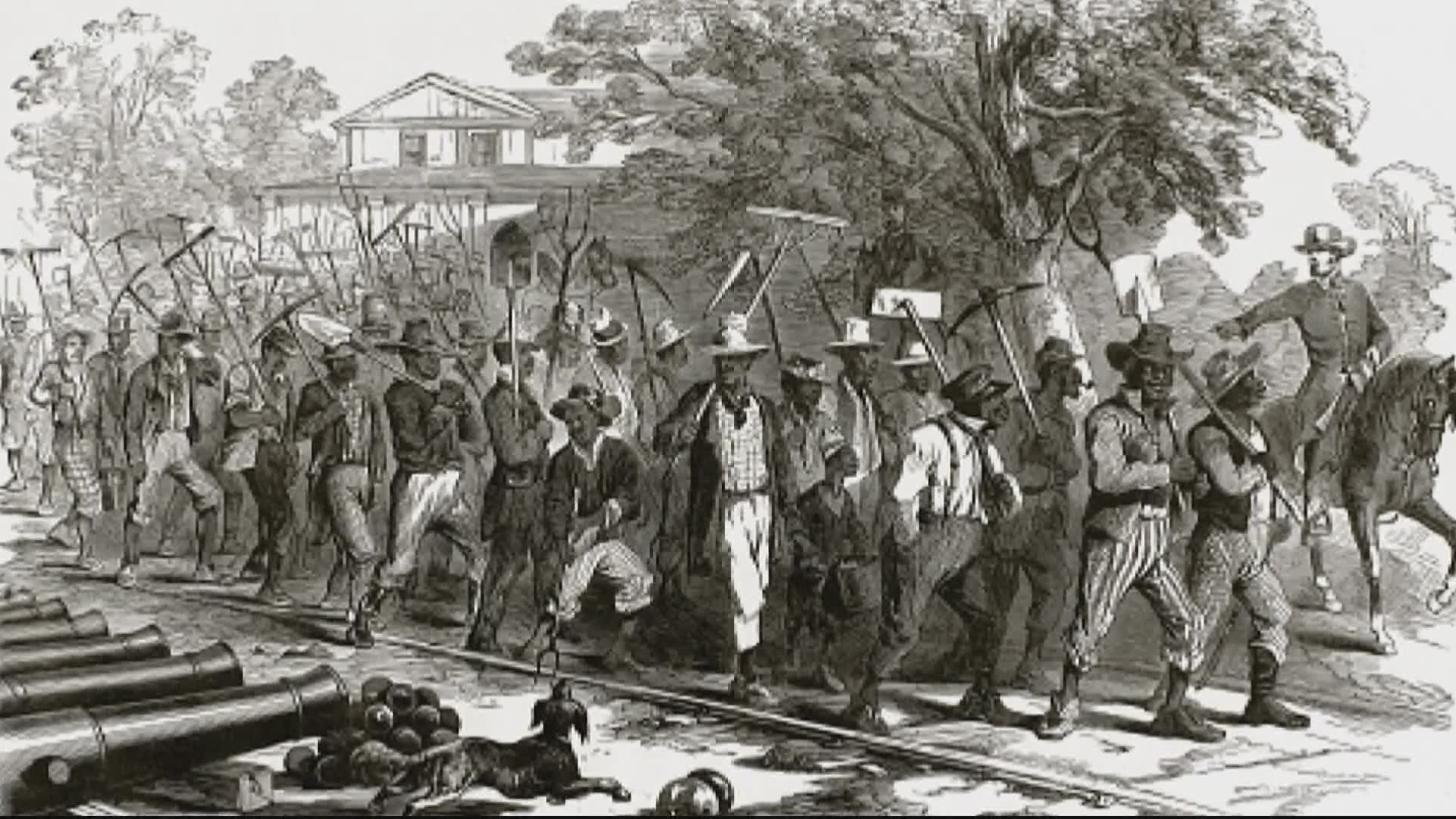WASHINGTON — Energy pulsed through the District Friday, despite intermittent rain and thunderstorms, as joy mixed with demands for change this Juneteenth. Dozens of demonstrations highlighted the systemic issues impacting the Black community, from disparities in education to personal experiences of police brutality.
Juneteenth is historically a joyful day commemorating freedom for the last enslaved populations in the remote location of Galveston, Texas -- two and a half years after the Emancipation Proclamation was signed in 1863. But on the heels of four weeks of nationwide protests after George Floyd's death, the urgent desire for change was palpable.
Just before 10:30 p.m., a group gathered outside MPD headquarters, unfurling a "defund the police" banner and throwing ropes around D.C.'s only outdoor Confederate statue -- of Brigadier General Albert Pike -- attempting to topple it. Less than an hour later, the statue came tumbling down, where protesters lit it on fire and watched it burn.
Earlier in the day, crowds marched and rallied peacefully all across the city, from the National Museum of African American History and Culture to the Martin Luther King Jr. Memorial, the newly named Black Lives Matter Plaza, on 14th and U Streets, and outside the White House. The Lincoln Memorial served as a fitting backdrop for a day that married history and the fight for human rights.
Some expressed themselves through dance, others recited poetry or shared their own testimonies, including Wizards shooting guard Bradley Beal who detailed his experience of racial profiling.
"Our hearts hold suffering and strength," one demonstrator at the Lincoln Memorial said. "Our mothers create us from their own flesh, and our fathers raise us to survive."
Here's a play-by-play of June 19, 2020:
11:48 p.m.: DC Council tweeted out that some members have been trying to get the statue of Albert Pike since 1992.
11:34 p.m.: Police arrive and put out the fire on the statue.
11:20 p.m.: D.C.'s only outdoor Confederate statue has been torn down, and is burning on the ground.
10:25 p.m.: Protesters gathered outside DC Police headquarters, where they have a statue of Confederate General Albert Pike tied up and are attempting to topple it.
10 p.m.: 295 North/Southbound entrances towards Westbound SW Freeway are closed due to protesters attempts to block traffic
7:10 p.m.: More people are showing up near the White House as marches and rallies seen in the District go into the evening.
6:45 p.m.: People are gathering at the corner of 16th and I to sign a poster with their names, messages of hope, and the names of black people killed by police.
6:40 p.m. Mochella is leading an impromptu dance party at 14th and U
6:11 p.m.: Rallies and marches continue towards and near the White House. Lots of positivity and energy being felt amid those gathered.
5:47 p.m.: A festive atmosphere is being seen in the District near Black Lives Matter Plaza as many continue to commemorate Juneteenth. Music and food have been prevalent.
5:08 p.m.: Go-Go legend Sugar Bear performs at Black Lives Matter Plaza, as rain in the District has lessened since earlier this afternoon around 3 p.m.
4:55 p.m.: Go-Go music continues to head downtown, with organizers saying they are using the music to commemorate the culture the music has brought to Black life in DC. Flatbed trucks with signs like "free victims of unjust crime" roll through.
"It's the background music of our streets," one protester said of the music.
4:31 p.m.: Legendary Go-Go musicians Sugar Bear, EU and Back Yard Band are spreading messages of solidarity with their music on floats heading towards Black Lives Matter Plaza via U. Street.
4:22 p.m.: "We need to follow the Bible, not the Constitution," says one protester downtown near Lafayette Park. Demonstraters say a man dressed as Jesus on a cross has been drawing attention, but ultimately confusing the message of the group.
4:15 p.m.: As rain continues to pick up near the Mall, several activist groups are beginning to pack up and go home.
3:50 p.m.: Protesters moving from the Lincoln Memorial are now heading down Pennsylvania Avenue towards the White House, marching even as rain continues to pour.
3:41 p.m.: Alpha chapter members of Omega Psi Phi are out near BLM plaza, cooking up barbeque and helping people register to vote.
3:30 p.m. Mayor Muriel Bowser presents the Black Lives Matter Plaza sign to the Dr. Crew at the Smithsonian's African American History and Culture Museum.
3:15 p.m: Yamilet Ventura turns 15 this August. She came to BLM Plaza to take her quinceñera pictures. She’s holding sage while walking through BLM plaza with a number of signs. One sign says “Teach your children how vile racism is” and “USA needs a cleansing.”
3:06 p.m. As rain begins to lightly drizzle over crowds, people gather outside Mayor Muriel Bowser's Office. Speaker addressing issues like defunding police and improving affordable housing, while some are registering to vote.
2:41 p.m. As crowd sizes grow even near the Lincoln Memorial, people begin sharing personal testimonies and calls for justice. Well over a thousand people are in attendance.
2:30 p.m. Crowds have now doubled in size at the Freedom Plaza, with signs reading "More than a hashtag. More than a trend." and some urging to defund the police.
2:19 p.m. -- In front of the Martin Luther King Jr. Memorial, dozens take an 8 minute and 46 second moment of silence in remembrance of George Floyd.
2:03 p.m. -- As they continue to march westbound on Pennsylvania Ave crossing 11th St NW, children are seen holding their fists up in solidarity with marchers. Some cheer, some hula hoop, and some are seen decorating signs.
1:41 p.m. -- Organizers with 2020 Freedom March gather outside of the Smithsonian's National Museum of African American History.
1:33 p.m.: In front of the White House dozens of bikers make their way through the streets. The group started down 16th Street before stopping at Lafayette Park.
1:10 p.m. -- Outside of the African American Civil War Museum, speakers continue to share their own testimonies.
"How many marches does it take for freedom?" one speaker shares.
12:55 p.m. - Across town, here's the current rooftop view of the Black Lives Matter mural near the White House.

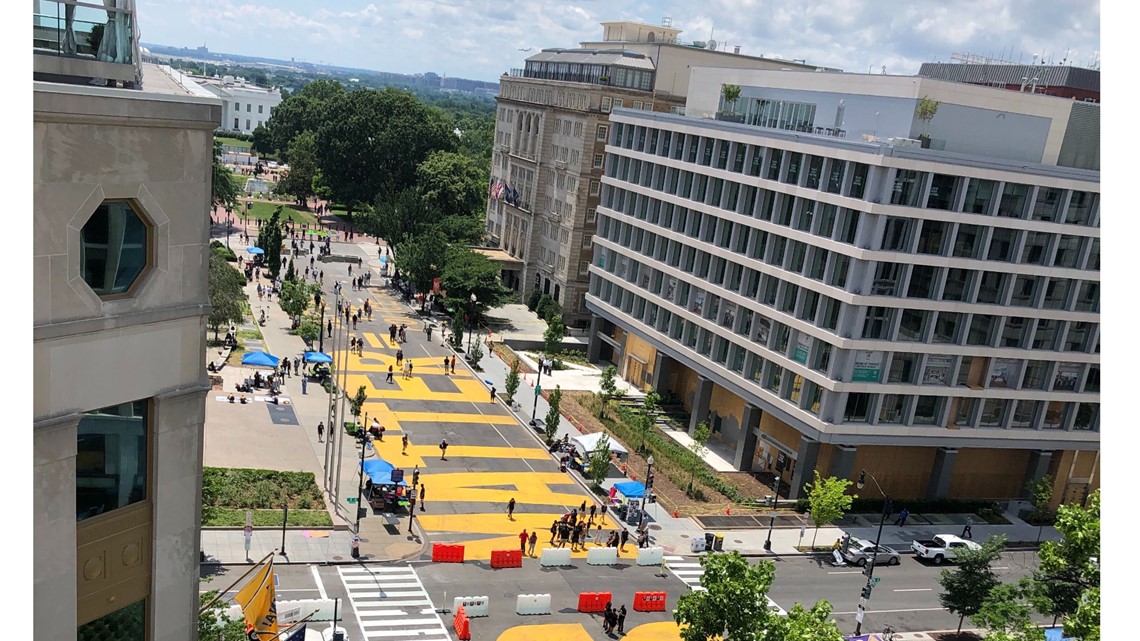
12:50 p.m. -- Sharing personal stories of what Juneteenth means to them, demonstrators speak outside the US Department of Education building. Some advocate for increased school funding, others about personal encounters with police and defunding school police.
The main speakers are from Educators for Equity, an activist group focused on changing school policy within the District.
10-year-old Gracie shares her own message with onlookers.
"Black students like me need clean and beautiful schools," she recites on stage. "Hey Black child? Do you know who you really are? Do you know you can be who you want to be and learn what you want to be?"
12:45 p.m.-- The intersection of Massachusetts Avenue and Wisconsin Avenue in Northwest DC is temporarily shut down by DC Police Department for one of many #JuneteenthDay marches around the city.
12:30 p.m. -- The Teacher of the Year for 2020 gives a speech at a Black Students Matter rally in front of the US Dept. of Education, calling for the district to fund the schools more efficiently and prioritize black education.

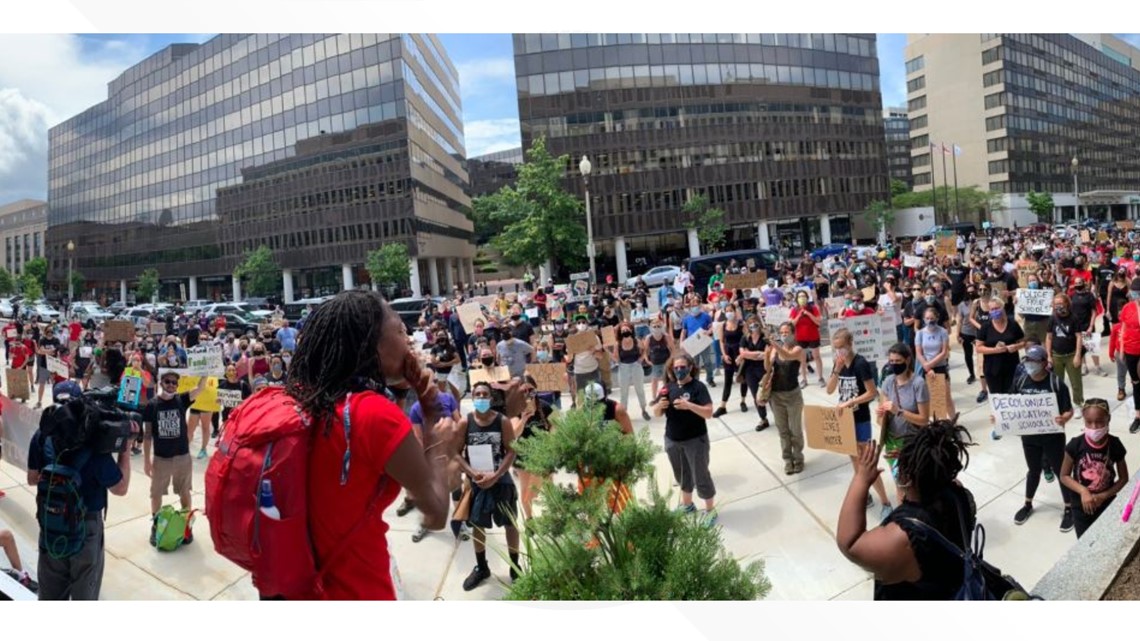
12:12 p.m.: Kevin Creamer, an organizer with the Freedom Day March, speaks to activists and supporters outside the African American Civil War Museum on what this day means to him.
"Today we are out to unify the collective, everybody every race and gender and sexuality. Justice is in the palms of our hands and we need to march for true freedom, without hindrance or restrictions."
"Today for me, is a celebration of black culture... we are living in conditional freedom." The group plans on marching towards the MLK Memorial in a few minutes.
12:10 p.m,.-- In front of Capital One Arena, Wizard's Bradley Beal shares his support for activists and his own encounters with police.
Meanwhile at RFK Stadium, the state of Redskins Founder and former owner is removed.
12:01 p.m.: "We have to take a stand and say enough is enough," says one organizer down at the African American Civil War Museum.
Southern Christian Leadership members and officials from D.C. Council have shown up to the museum, with speakers and drum players outside the front of the building.
11:52 a.m. -- Down by the National Mall, peaceful demonstrations continue. Sage burning, yoga and guided meditation activities start near the Washington Monument, with flutes and jazz music playing.


11:40 a.m. -- Students and demonstrators carry on from the Freedom Plaza towards the U.S. Department of Education, chanting "1, 2, 3, 4 Black kids deserve more!" Car horns, cheers and claps follow as crowd size gains momentum down the block.
11:30 a.m. - By the new Black Lives Matter Plaza DC, a group of independent dancers say they are using the day to honor history with dance and are creating a documentary to express how they feel about the need for equality and justice.

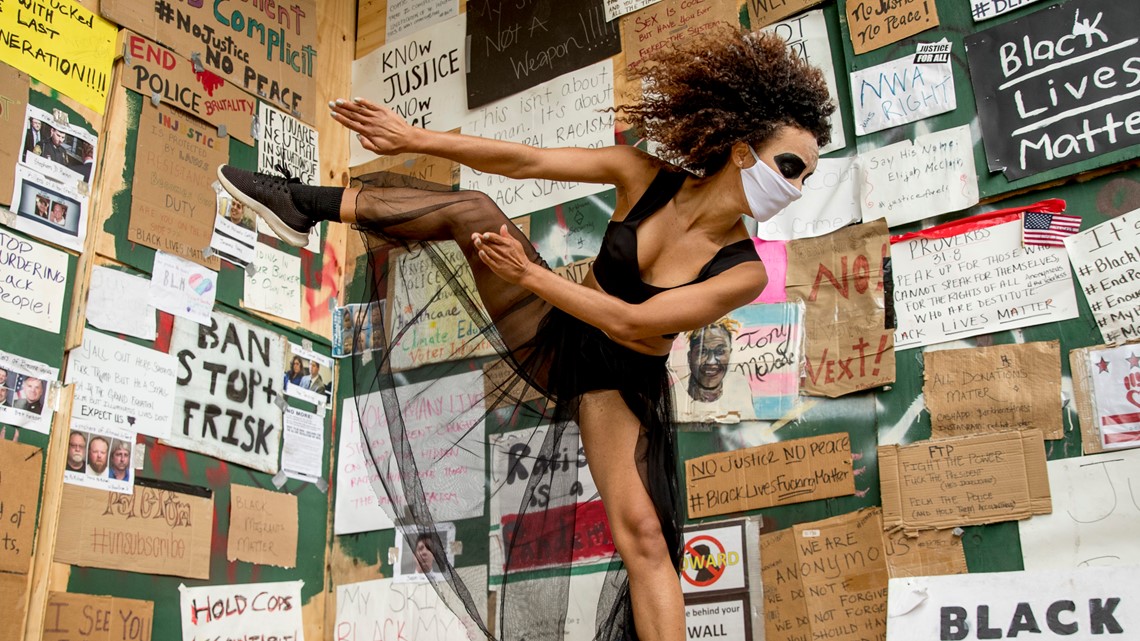
Street performers are gathered on the plaza, decked with musical instruments and boomboxes for dance routines.
"Dancing has pressed us to be better human beings, and we celebrate our blackness and our beauty and are so grateful to express and share that today," one dancer says.
11:00 a.m. -- Near the Freedom Plaza, students gear up for demonstrations. Sign making and t-shirts are passed out as the plan on marching towards the U.S. Department of Education.
"Black Students Matter!" reads a handful of signs.
RELATED: Organizers gearing up for Black Students Matter rally to highlight disparities in education
10:34 a.m. -- Dozens of people take a knee and moment of silence for 8 minutes and 46 seconds in Ward 8 in remembrance of George Floyd.

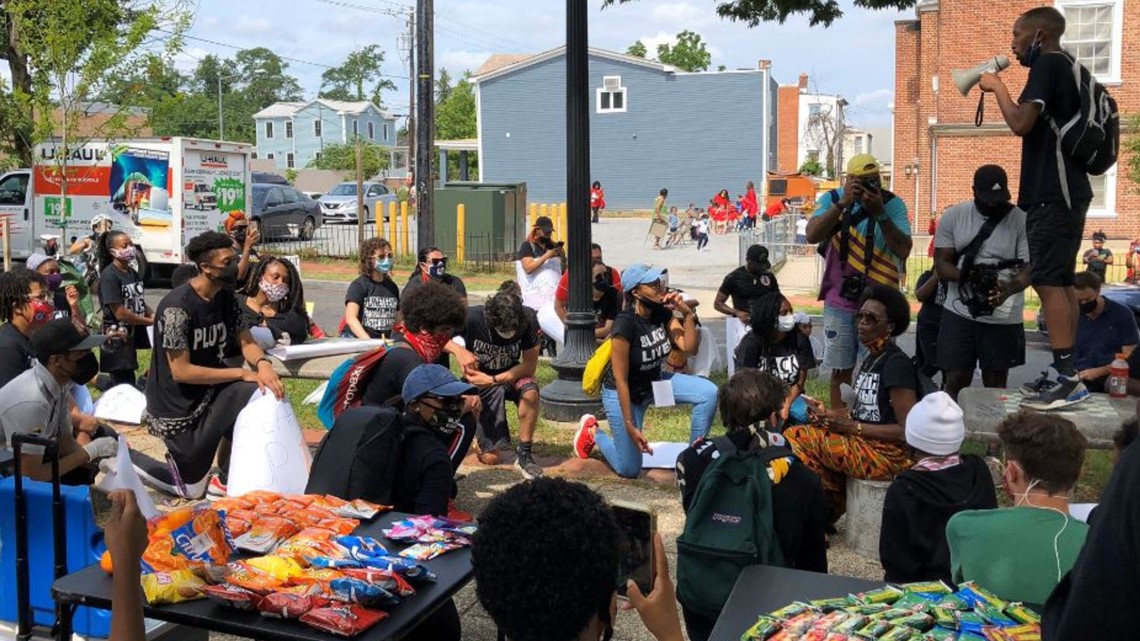
10:01 a.m. -- Near St. Johns Church downtown, people begin to gather with signs and some mild chants. Law enforcement are seen outside of the White House as some gather by the new Black Lives Matter Plaza.
9:45 a.m. -- In Ward 8, demonstrators of all ages have shown up with signs in solidarity for Black Lives Matter. "We're here to remember all those who fought before us," one protester tells WUSA9 with his daughter.
9:30 a.m. -- A peaceful march and rally begin on Martin Luther King Jr. Avenue with hundreds expected to show. Tables of supplies are set up off the street, with water bottles and snacks available for protesters.
8:30 a.m. -- Dozens of roads are closed downtown as law enforcement prepares for thousands of demonstrators.

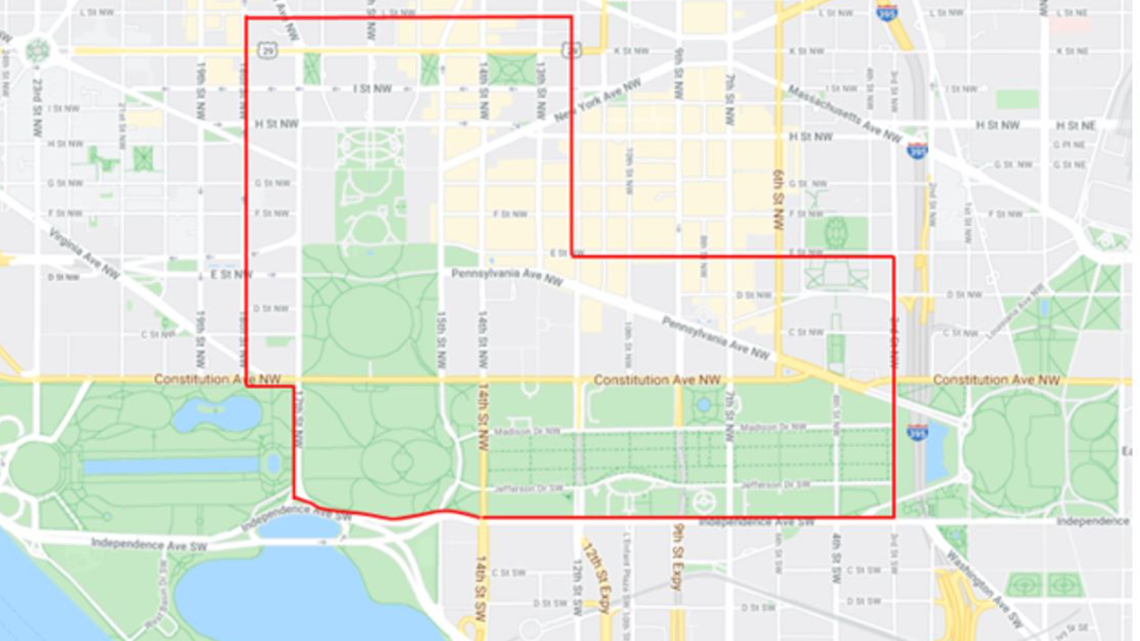
What is Juneteenth?
The end of slavery in the United States is often recognized by President Abraham Lincoln’s Emancipation Proclamation of 1863. But the holiday commemorating the freedom of African Americans, Juneteenth -- June 19, was recognized only after the last slaves were told about the president’s order nearly 2 1/2 years later.
The word Juneteenth is a combination of the month and date that the holiday is observed, on June 19. On that day in 1865, Union troops led by Maj. Gen. Gordon Granger arrived in Galveston, Texas, with news that the Civil War was over, and that all remaining slaves were free. Lincoln announced the Emancipation Proclamation that had declared their freedom in September 1862. The order was issued during the Civil War and effective January 1, 1863.
Granger read General Order No. 3 after his arrival:
"The people of Texas are informed that in accordance with a Proclamation from the Executive of the United States, all slaves are free. This involves an absolute equality of rights and rights of property between former masters and slaves, and the connection heretofore existing between them becomes that between employer and hired laborer."
Why it took so long to get the news to Texas remains unclear. According to Juneteenth.com, one belief is that a messenger sent to give word of the newly declared freedoms was murdered. Another is that the news was deliberately withheld by slave owners. And there was the fact that there were few Union soldiers in Texas to deliver the news.
According to historian Henry Louis Gates Jr., the order did not mean immediate freedom for many of Texas' 250,000 slaves. It was the owners who were tasked with delivering the news.
"On plantations, masters had to decide when and how to announce the news — or wait for a government agent to arrive — and it was not uncommon for them to delay until after the harvest," Gates said in a blog published by The Root and PBS.

